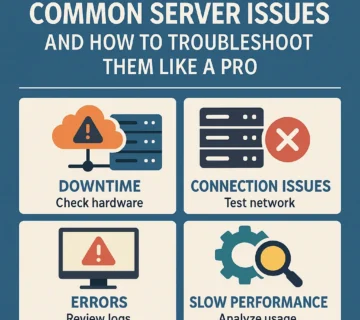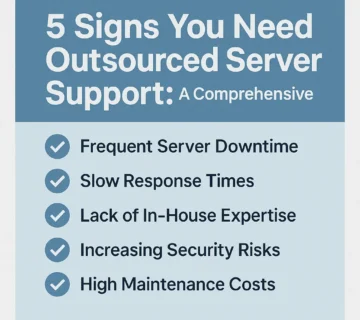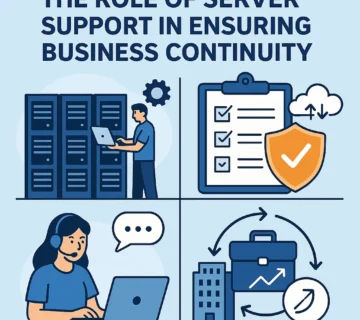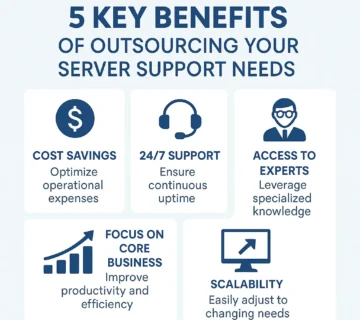The Role of Server Support in Preventing Cyber Threats

In today’s hyper-connected business landscape, cyber threats are evolving at an unprecedented pace. Organizations of all sizes rely on servers as the backbone of their operations—from storing mission-critical data to running applications, enabling remote work, and powering cloud environments. Yet despite this reliance, many companies underestimate just how crucial server support is in maintaining security and preventing cyberattacks.
Proper server support isn’t simply about keeping systems running. It’s a strategic approach that includes monitoring, maintenance, patching, hardening, performance optimization, disaster recovery, and compliance. When executed correctly, server support acts as a powerful line of defense against cyber threats such as ransomware, data breaches, insider attacks, zero-day exploits, and more.
In this blog, we’ll explore the essential role of server support in cybersecurity, the risks of ignoring it, best practices businesses should follow, and why professional server management is becoming non-negotiable for modern organizations.
Why Server Support Matters More Than Ever
Server environments—whether on-premises, cloud-based, or hybrid—store sensitive information such as customer data, financial records, intellectual property, and operational systems. This makes them prime targets for attackers.
The threat landscape includes:
-
Ransomware attacks that encrypt server files and halt operations
-
Data breaches caused by vulnerabilities or misconfigurations
-
Phishing-related credential theft that leads attackers into servers
-
Zero-day exploits targeting unpatched software
-
DDoS attacks overwhelming server capacity
-
Insider threats from disgruntled employees or accidental misuse
Without consistent support and oversight, servers become vulnerable to these threats. Even a single overlooked patch, misconfigured port, or weak security policy can open the door to catastrophic attacks.
How Server Support Helps Prevent Cyber Threats
Effective server support involves a multi-layered security approach. Here are the key components that directly help protect your organization from cyber risks.
1. Proactive Monitoring and Alerts
Continuous server monitoring detects anomalies such as:
-
Unusual login attempts
-
Spikes in traffic
-
Unauthorized file changes
-
Malware signatures
-
Resource usage irregularities
Advanced monitoring tools also issue real-time alerts so your IT team can act immediately. Early detection is one of the most effective ways to stop threats before they escalate.
2. Regular Patching and Updates
Unpatched servers are one of the top causes of cyberattacks.
Server support ensures:
-
Operating system updates
-
Software patches
-
Security remediation
-
Firmware updates
When left unpatched, vulnerabilities accumulate, making your server an easy target. By staying current with updates, organizations close potential entry points and drastically reduce the risk of exploitation.
3. Server Hardening and Configuration Management
Hardening means reducing the attack surface of your servers. This includes:
-
Disabling unnecessary open ports
-
Removing unused applications
-
Enforcing strong firewall rules
-
Applying group security policies
-
Configuring secure service permissions
-
Implementing multi-factor authentication
Proper configuration prevents attackers from exploiting weak or default settings—one of the most common causes of breaches.
4. Data Backup and Disaster Recovery Planning
Cybersecurity isn’t just about preventing attacks—it’s also about resilience.
Strong server support includes:
-
Off-site and cloud backups
-
Regular backup testing
-
Snapshot-based recovery
-
Ransomware-resistant backup systems
In the event of a cyberattack, disaster recovery protocols ensure business continuity and minimal downtime.
5. Access Control and Identity Management
Controlling who can access what is a core element of cybersecurity.
Server support teams implement:
-
Role-based access controls (RBAC)
-
Privilege management
-
Multi-factor authentication (MFA)
-
Password policies
-
Logging of user actions
These measures limit the potential damage that compromised accounts or insider threats can cause.
6. Malware Protection and Security Tools
Server support integrates advanced cybersecurity tools such as:
-
Endpoint detection and response (EDR)
-
Antivirus and anti-malware solutions
-
Intrusion detection systems (IDS)
-
Intrusion prevention systems (IPS)
-
Web application firewalls
By layering security technologies, servers are protected against known and emerging threats.
7. Cloud and Virtual Environment Security
Modern businesses rely on cloud servers and virtual machines (VMs). Server support includes:
-
Secure cloud configuration
-
Virtual environment segmentation
-
API access control
-
Cloud workload protection platforms (CWPP)
These environments are dynamic, making automated monitoring and management essential.
8. Logging, Reporting, and Auditing
Security logs help identify attack patterns and investigate breaches.
Server support ensures the proper logging of:
-
Access attempts
-
File changes
-
Network connections
-
Administrative actions
These logs are critical for forensics, compliance, and ongoing security improvements.
Common Risks When Server Support Is Ignored
Businesses that overlook proper server management face significant risks, including:
1. Larger Attack Surface
Unpatched vulnerabilities accumulate, making servers easier to compromise.
2. Extended Downtime During Attacks
Without a recovery plan, even small incidents can cause prolonged outages.
3. Data Loss and Corruption
Poor backup strategies put sensitive information at risk.
4. Financial Loss
Cyberattacks cost businesses millions in downtime, legal fees, and customer loss.
5. Compliance Violations
Industries such as healthcare, finance, and legal must follow strict compliance rules. Poor server management can lead to fines or lawsuits.
6. Reputation Damage
Clients expect their data to be secure. One breach can erode trust permanently.
Best Practices for Server Support to Strengthen Cybersecurity
Here are actionable recommendations that every organization should follow:
-
Use automated monitoring tools for 24/7 threat detection
-
Implement MFA for all server access
-
Run regular vulnerability scans
-
Apply security patches within 24–72 hours of release
-
Encrypt data at rest and in transit
-
Install firewalls and intrusion detection systems
-
Segment networks to contain potential breaches
-
Test backups monthly
-
Review user permissions quarterly
-
Document and update policies as threats evolve
These practices create a solid defense against cyberattacks and ensure your servers stay compliant and secure.
Why Businesses Should Consider Professional Server Support Services
Managing servers internally requires:
-
Skilled IT personnel
-
Dedicated monitoring tools
-
Up-to-date cybersecurity knowledge
-
Time and resources
Most small and mid-sized organizations lack the internal capacity to handle all this effectively.
Professional server support services offer:
-
24/7 monitoring
-
Preventive maintenance
-
Rapid incident response
-
Expert security configuration
-
Compliance-driven management
-
Predictable monthly costs
This allows businesses to stay secure without the overhead of a full internal IT team.
FAQ: Server Support & Cyber Threat Prevention
1. What is server support?
Server support includes monitoring, maintenance, troubleshooting, patching, security management, and optimization for servers in on-premises, cloud, or hybrid environments.
2. How does server support prevent cyberattacks?
Server support reduces vulnerabilities through regular patching, monitoring, server hardening, access control, backups, and security tool integration—all of which block and detect threats early.
3. What happens if I don’t update my server regularly?
Unpatched servers become vulnerable to exploits, ransomware, and zero-day attacks, increasing the likelihood of a breach.
4. How often should a server be monitored?
Servers should be monitored 24/7, since cyberattacks can happen at any time—especially during off-hours when staffing is minimal.
5. Does cloud hosting eliminate the need for server support?
No. While cloud providers secure the infrastructure, businesses are still responsible for securing their data, applications, and configurations. Server support remains essential.
6. Can outsourcing server management improve security?
Yes. Managed IT providers offer specialized expertise, monitoring tools, and security systems that many businesses cannot implement internally.
7. What type of businesses need server support?
Any organization using servers—healthcare, finance, law, manufacturing, retail, education, and more—benefits from professional server support.
8. How does server support help with compliance?
Server support ensures secure configurations, access logging, patching, and documentation required for compliance standards like HIPAA, PCI-DSS, SOX, and GDPR.
9. What should I look for in a server support provider?
Look for 24/7 monitoring, security expertise, rapid response times, disaster recovery capabilities, compliance knowledge, and a proven track record.
10. How can I know if my server is secure?
A professional server assessment—including vulnerability scanning, configuration review, and security audit—can reveal whether your server is adequately protected.
Conclusion
Servers are the foundation of your business’s IT infrastructure, and cyber threats are more aggressive than ever. By investing in consistent, comprehensive server support, organizations can proactively defend against cyberattacks, secure sensitive information, and ensure operational continuity.
Whether you manage servers in-house or partner with a professional IT services provider, prioritizing server support is no longer optional—it’s essential for long-term business resilience.







No comment